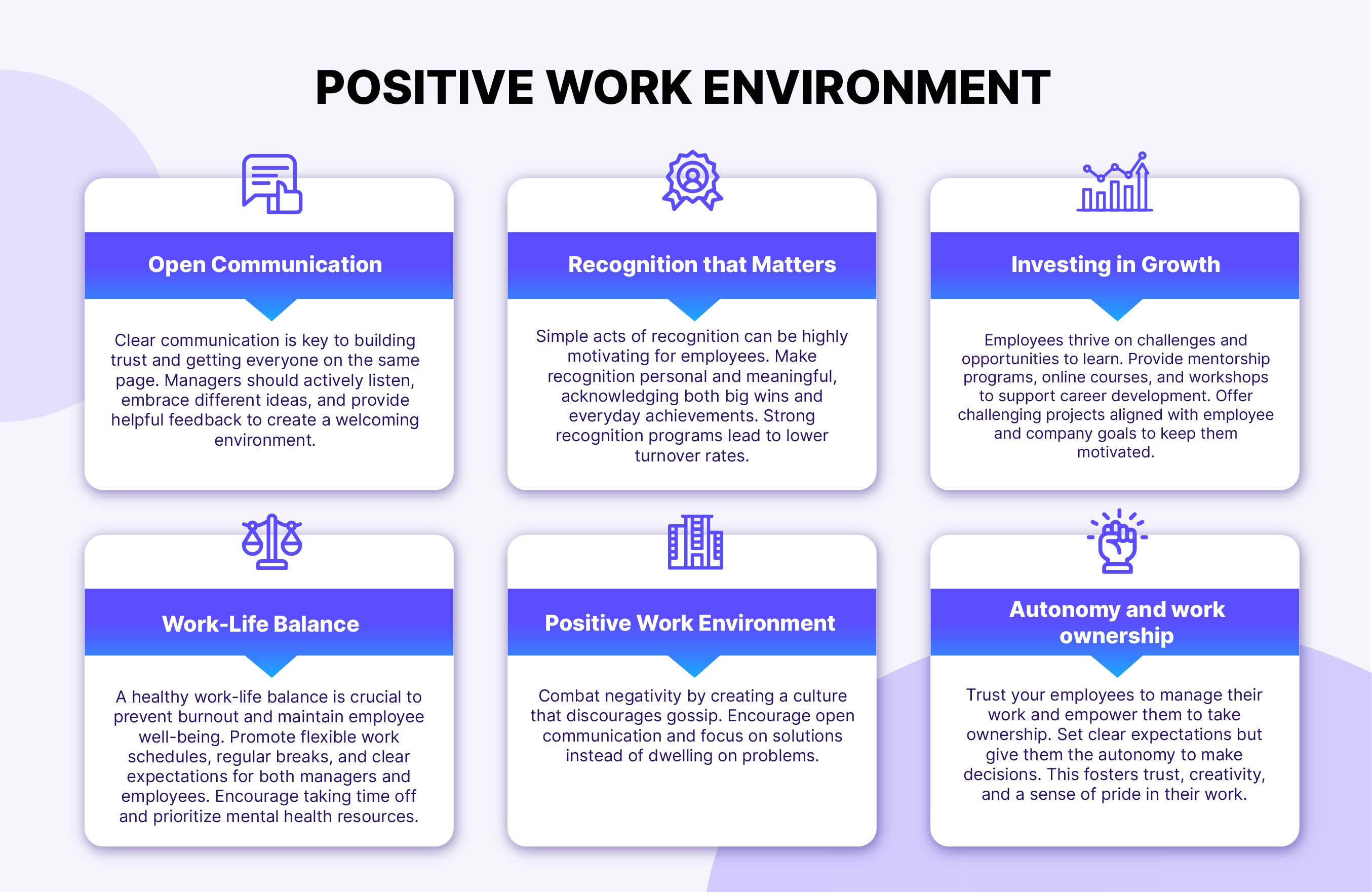Work isn't always great, that's a fact. Going through the difficulties of working effectively and bringing the company's employees together is not easy. But when you have a clear goal and plan to increase positive connections, it will help keep your business on track. So sit back, relax and join us as we explore six simple ways to increase employee engagement and improve working environment.
1. Froster open communication is key for employee engagement
An open communication culture needs to be developed that enables trust, collaboration, and connection with all other team members. For illustration, managers need to exercise active listening when they become all ears during the conversation, ask for clarification questions, and sum up the conversation to ensure they make sense. This clears any ambiguity that could have arisen between them and the employees and offers respect to employees.
Before becoming approachable, a manager ought to begin with small steps, such as greeting and sincere smiles to be approachable. Respecting divergent views and basing decisions on the group's rationale will help create an inclusive and respectful work environment.
Another precious way is to use tactful feedback, known as the "compliment sandwich" say something positive, then something to work on, followed by something else positive, always maintaining that the feedback is constructive and motivating.

2. Recognition program for boosting employee engagement
Recognition lies at the bottom of a good employee engagement process. Once employees feel that they have been recognized for their hard work and valued in some way, they are satisfied. Recognition does not necessarily have to be elaborate or expensive; a simple "thank you" or mention in a team meeting could motivate them.
The trick seems to be to give the recognition of some value, something in which it can be felt personally. It won't be vague certificates, it'll be something that appeals to people individually. For example, if a great logo has been designed, you would give the Designer a book on the subject or an online course.
Recognize major milestones and everyday achievements. Regular recognition for employees results in a 31% lower turnover rate* at companies with very strong recognition programs.
*Aberdeen Research "The Power of Employee Recognition."
3. Create a positive work environment
So, what to do with this spiral of negativity? Psychotherapist Glenn D. Rolfsen offers a simple solution called "Gossip 2016." Gather your team, define backbiting using a crafty trick known as the triple-filter test (is it true, sound, or valuable to share?), and have everyone commit to stopping gossip for six months. This combined with personal resolve in not participating in gossip outside one's place of work could greatly improve the morale and productivity of a workplace.

4. Investing in the people
While recognition is very critical to motivation, it is in providing employees with opportunities to grow and develop where management can engage employees. Most of the time, otherwise, employees could be demotivated and set to stagnate in their positions. Usually, people strive for more challenges and to try to improve.
This can be supported by the argument that ongoing recognition and some rewards would serve the motivational urge of workers, and it will not be necessary to always give tangible rewards to increase their level of commitment or effort.
Although this can be enough to create engagement for the short term, long-term engagement and satisfaction require more than just recognition. Workers want to see mechanisms through which they can grow and get equipped with preferred abilities that can enhance their resumes for better prospects. Lack of development opportunities eventually makes workers feel unfulfilled, hence decreasing their motivation and, consequently, potential turnover.
Supporting promotion and motivational enhancement involves the need for employers to:
- Transparency: Share mentorship programs and different training opportunities available. Connect team members with more senior leaders for mentorship. They should also have access to online courses, workshops, and conferences to boost their skill development.
- Accessible learning opportunities: Establish a platform where employees can easily be directed to and enrolled in relevant courses, workshops, and conferences. Work to negotiate discounted access to resource pools from educational institutions or professional organizations.
- Challenging projects in line with career objectives: Assign projects related to an employee's aspiration in their career and the company's needs. Possible projects could be about leading cross-functional teams, heading up innovative processes, or solving staggering problems. This will ensure that employees are always interested in growing in their current jobs, leading to long-term development and engagement.

5. Work-life balance that boosts Employee Engagement
Even the most dedicated employees need time to recharge. Well-being and engagement are directly connected to work-life balance. Overworking results in the loss of crew members and, hence, affects organizational health and productivity.
Let's discover some of the practical tips that can be useful for managers and employees to ensure a balanced life. These strategies do not only increase job satisfaction but also lead to a more motivated and efficient team.
For Managers:
- Encourage flexible working hours: Allowing employees to have flexible work schedules can make a significant difference. When employees can manage their work hours around their commitments, they are more likely to be productive and less stressed.
- Tip: Implement a policy where employees can start earlier or later in the day to accommodate their personal needs.
- Promote regular breaks: Continuous work without breaks leads to burnout. Managers should encourage their teams to take short, regular breaks throughout the day. This practice boosts productivity and helps maintain mental well-being.
- Tip: Suggest a short walk or a coffee break every couple of hours.
- Set clear expectations: Unclear expectations can cause unnecessary stress. Managers should communicate clearly about project deadlines, work hours, and performance expectations. This clarity helps employees manage their time effectively.
- Tip: Regular check-ins and updates can keep everyone on the same page.
For Employees:
- Prioritize tasks: Not all tasks are created equal. Employees should learn to prioritize their workload based on urgency and importance. This practice helps in managing time better and reducing the feeling of being overwhelmed.
- Tip: Create a daily to-do list and focus on high-priority tasks first.
- Establish boundaries: It's important to set boundaries between work and personal life. Employees should establish specific work hours and stick to them as much as possible. This helps in ensuring that work does not encroach on personal time.
- Tip: Turn off work notifications after work hours to avoid distractions.
- Take time for personal activities: Engaging in hobbies, spending time with loved ones, and taking care of one's health are crucial for maintaining a balanced life. Employees should make it a point to dedicate time to these activities regularly.
- Tip: Schedule personal activities just as one would schedule work meetings.
In the end, it all boils down to this. A well-rested and balanced employee is going to be more engaged and productive. Therefore, a "Healthy" environment that supports and enhances mental health will enable businesses to excel like never before.
6. Autonomy for trust and commitment
Trust someone. As said, occasionally, to use someone, you'll have to trust them. If you doubt they can be trusted, pretty much you shouldn't use them. An article in the International Journal of Health Sciences and Research brings to the forefront the direct positive correlation of self-efficacy of corporate employees in India with work autonomy and job satisfaction. More self-efficacy and more work autonomy directly increase job satisfaction, whereas gender and educational background have little effect on job satisfaction.
Hence, every manager should foster a sense of autonomy and ownership. Trusting your employees to manage their tasks autonomously and to have ownership in decisions will lead to their success.





